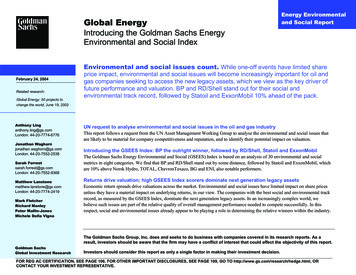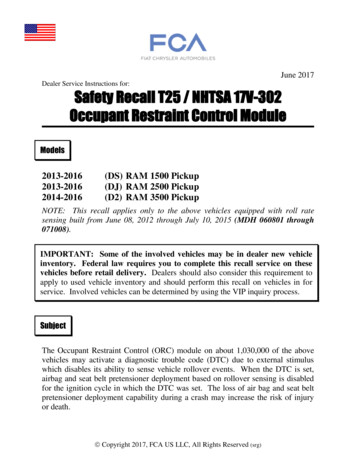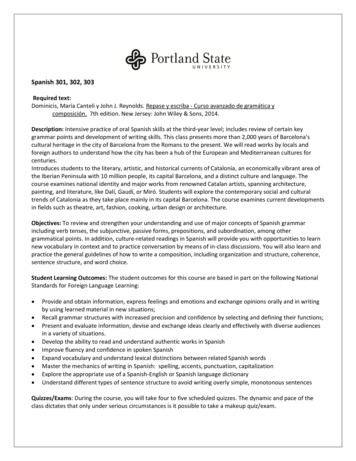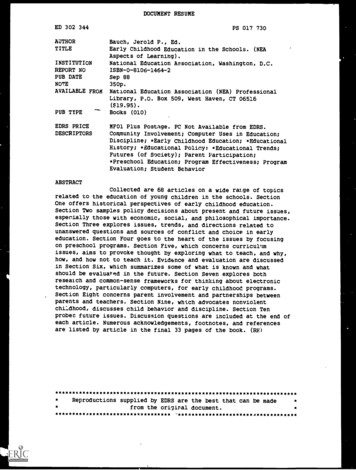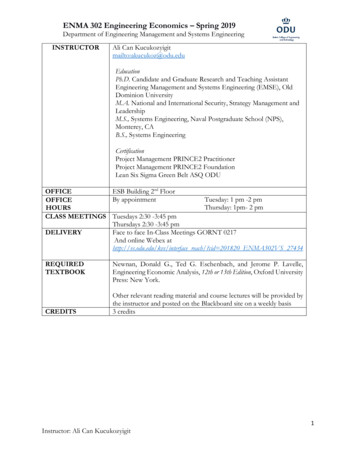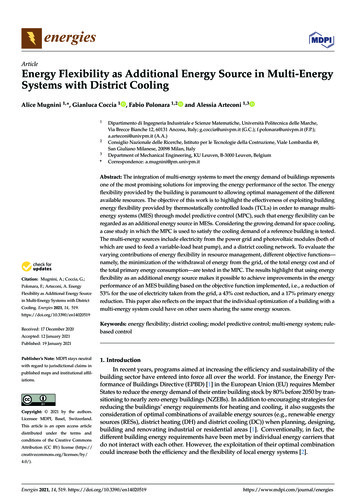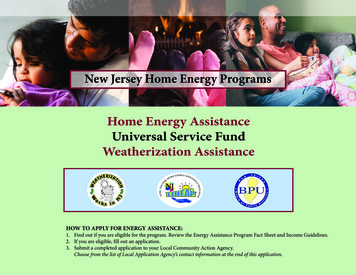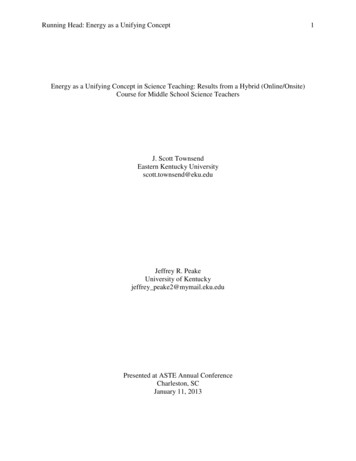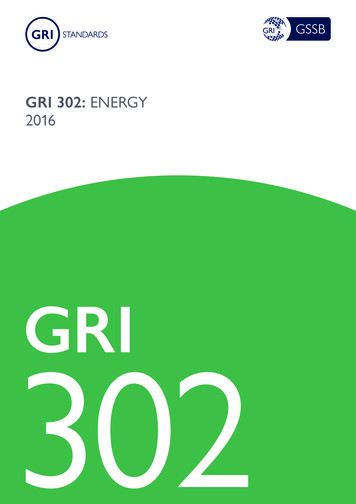
Transcription
GRI 302: ENERGY2016GRI302
ContentsIntroduction3GRI 302: Energy51. Management approach disclosures2. Topic-specific disclosuresDisclosure 302-1 Energy consumption within the organization Disclosure 302-2 Energy consumption outside of the organizationDisclosure 302-3 Energy intensityDisclosure 302-4 Reduction of energy consumptionDisclosure 302-5 Reductions in energy requirements of products and services5668101112Glossary13References15About this StandardResponsibilityThis Standard is issued by the Global Sustainability Standards Board (GSSB).Any feedback on the GRI Standards can be submitted tostandards@globalreporting.org for the consideration of the GSSB.ScopeGRI 302: Energy sets out reporting requirements on the topic of energy. This Standardcan be used by an organization of any size, type, sector or geographic location thatwants to report on its impacts related to this topic.NormativereferencesThis Standard is to be used together with the most recent versions of the followingdocuments.GRI 101: FoundationGRI 103: Management ApproachGRI Standards GlossaryIn the text of this Standard, terms defined in the Glossary are underlined.Effective dateThis Standard is effective for reports or other materials published on or after1 July 2018. Earlier adoption is encouraged.Note: This document includes hyperlinks to other Standards. In most browsers, using ‘ctrl’ click willopen external links in a new browser window. After clicking on a link, use ‘alt’ left arrow to return tothe previous view.2GRI 302: Energy 2016
IntroductionA. OverviewThis Standard is part of the set of GRI SustainabilityReporting Standards (GRI Standards). These Standardsare designed to be used by organizations to reportabout their impacts on the economy, the environment,and society.The GRI Standards are structured as a set ofinterrelated, modular standards. The full set can bedownloaded at www.globalreporting.org/standards/.There are three universal Standards that apply to everyorganization preparing a sustainability report:GRI 101: FoundationGRI 102: General DisclosuresGRI 103: Management ApproachFigure 1Overview of the set of GRI StandardsStarting pointfor using theGRI eralDisclosuresManagementApproachGRIGRI103To report themanagement approachfor each material topicEconomicEnvironmentalSocialGRIGRIGRI200GRI 302: Energy is a topic-specific GRI Standardin the 300 series (Environmental topics).There are two basic approaches for using the GRIStandards. For each way of using the Standards thereis a corresponding claim, or statement of use, whichan organization is required to include in any publishedmaterials.1. T he GRI Standards can be used as a set to preparea sustainability report that is in accordance withthe Standards. There are two options for preparinga report in accordance (Core or Comprehensive),depending on the extent of disclosures included inthe report.An organization preparing a report in accordancewith the GRI Standards uses this Standard,GRI 302: Energy, if this is one of its material topics.UniversalStandardsTo report contextualinformation aboutan organizationEach topic Standard includes disclosures specific tothat topic, and is designed to be used together withGRI 103: Management Approach, which is used toreport the management approach for the topic.B. Using the GRI Standards and making claimsGRI 101: Foundation is the starting point for usingthe GRI Standards. It has essential informationon how to use and reference the Standards.102An organization then selects from the set of topicspecific GRI Standards for reporting on its materialtopics. These Standards are organized into three series:200 (Economic topics), 300 (Environmental topics) and400 (Social topics).3002. S elected GRI Standards, or parts of their content,can also be used to report specific information,without preparing a report in accordance withthe Standards. Any published materials that usethe GRI Standards in this way are to include a‘GRI-referenced’ claim.See Section 3 of GRI 101: Foundation for moreinformation on how to use the GRI Standards,and the specific claims that organizations arerequired to include in any published materials.400Select from these to report specific disclosuresfor each material topicGRI 302: Energy 20163
C. Requirements, recommendations and guidanceThe GRI Standards include:Requirements. These are mandatory instructions.In the text, requirements are presented in bold fontand indicated with the word ‘shall’. Requirements areto be read in the context of recommendations andguidance; however, an organization is not required tocomply with recommendations or guidance in orderto claim that a report has been prepared in accordancewith the Standards.Recommendations. These are cases where a particularcourse of action is encouraged, but not required. In thetext, the word ‘should’ indicates a recommendation. Guidance. These sections include backgroundinformation, explanations and examples to helporganizations better understand the requirements.An organization is required to comply with all applicablerequirements in order to claim that its report has beenprepared in accordance with the GRI Standards. SeeGRI 101: Foundation for more information.D. Background contextIn the context of the GRI Standards, the environmentaldimension of sustainability concerns an organization’simpacts on living and non-living natural systems, includingland, air, water and ecosystems.GRI 302 addresses the topic of energy.An organization can consume energy in various forms,such as fuel, electricity, heating, cooling or steam.Energy can be self-generated or purchased fromexternal sources and it can come from renewablesources (such as wind, hydro or solar) or fromnon-renewable sources (such as coal, petroleumor natural gas).Using energy more efficiently and opting for renewableenergy sources is essential for combating climate changeand for lowering an organization’s overall environmentalfootprint.Energy consumption can also occur throughout theupstream and downstream activities connected withan organization’s operations. This can include consumers’use of products the organization sells, and the end-of-lifetreatment of these products.The disclosures in this Standard can provide informationabout an organization’s impacts related to energy, andhow it manages them.4GRI 302: Energy 2016
GRI 302:EnergyThis Standard includes disclosures on the management approach and topic-specificdisclosures. These are set out in the Standard as follows: Management approach disclosures (this section references GRI 103) Disclosure 302-1 Energy consumption within the organization Disclosure 302-2 E nergy consumption outside of the organization Disclosure 302-3 Energy intensity Disclosure 302-4 Reduction of energy consumption Disclosure 302-5 Reduction in energy requirements of products and services1. Management approach disclosuresManagement approach disclosures are a narrative explanation of how an organization manages a material topic,the associated impacts, and stakeholders’ reasonable expectations and interests. Any organization that claims itsreport has been prepared in accordance with the GRI Standards is required to report on its management approachfor every material topic, as well as reporting topic-specific disclosures for those topics.Therefore, this topic-specific Standard is designed to be used together with GRI 103: Management Approach in orderto provide full disclosure of the organization’s impacts. GRI 103 specifies how to report on the management approachand what information to provide.Reporting requirements1.1 The reporting organization shall report its management approach for energy using GRI 103:Management Approach.GuidanceWhen reporting its management approach for energy,the reporting organization can also explain whetherit is subject to any country, regional, or industry-levelenergy regulations and policies. Additionally, it canprovide examples of these regulations and policies.GRI 302: Energy 20165
2. Topic-specific disclosuresDisclosure 302-1Energy consumption within the organizationReporting requirementsThe reporting organization shall report the following information:a. Total fuel consumption within the organization from non-renewable sources, in joulesor multiples, and including fuel types used.b. Total fuel consumption within the organization from renewable sources, in joulesor multiples, and including fuel types used.c. In joules, watt-hours or multiples, the total:Disclosure302-1i.electricity consumptionii. heating consumptioniii. cooling consumptioniv. steam consumptiond. In joules, watt-hours or multiples, the total:i.electricity soldii. heating soldiii. cooling soldiv. steam solde. Total energy consumption within the organization, in joules or multiples.f.Standards, methodologies, assumptions, and/or calculation tools used.g. Source of the conversion factors used.2.1 When compiling the information specified in Disclosure 302-1, the reporting organization shall:2.1.1 avoid the double-counting of fuel consumption, when reporting self-generated energyconsumption. If the organization generates electricity from a non-renewable or renewablefuel source and then consumes the generated electricity, the energy consumption shallbe counted once under fuel consumption;2.1.2report fuel consumption separately for non-renewable and renewable fuel sources;2.1.3only report energy consumed by entities owned or controlled by the organization;2.1.4 calculate the total energy consumption within the organization in joules or multiplesusing the following formula:6GRI 302: Energy 2016
Disclosure 302-1ContinuedTotal energy consumption within the organization Non-renewable fuel consumed Renewable fuel consumed Electricity, heating, cooling, and steam purchased for consumption Self-generated electricity, heating, cooling, and steam,which are not consumed (see clause 2.1.1)Electricity, heating, cooling, and steam soldReporting recommendations2.2 When compiling the information specified in Disclosure 302-1, the reporting organization should:2.2.1apply conversion factors consistently for the data disclosed;2.2.2use local conversion factors to convert fuel to joules, or multiples, when possible;2.2.3use the generic conversion factors, when local conversion factors are unavailable;2.2.4if subject to different standards and methodologies, describe the approach to selecting them;2.2.5 select a consistent topic Boundary for energy consumption. When possible, the Boundary shouldbe consistent with that used in Disclosures 305-1 and 305-2 of GRI 305: Emissions;2.2.6 where it aids transparency or comparability over time, provide a breakdown of energy consumptiondata by:2.2.6.1business unit or facility;2.2.6.2country;2.2.6.3 type of source (see definitions for the listing of non-renewable sources andrenewable sources);2.2.6.4type of activity.GuidanceBackgroundFor some organizations, electricity is the onlysignificant form of energy they consume. For others,energy sources such as steam or water provided froma district heating plant or chilled water plant can alsobe important.Energy can be purchased from sources external tothe organization or produced by the organizationitself (self-generated).Non-renewable fuel sources can include fuel forcombustion in boilers, furnaces, heaters, turbines,flares, incinerators, generators and vehicles thatare owned or controlled by the organization. Nonrenewable fuel sources cover fuels purchased bythe organization. They also include fuel generatedby the organization’s activities – such as mined coal,or gas from oil and gas extraction.Renewable fuel sources can include biofuels, whenpurchased for direct use, and biomass in sourcesowned or controlled by the organization.Consuming non-renewable fuels is usually the maincontributor to direct (Scope 1) GHG emissions, whichare reported in Disclosure 305-1 of GRI 305: Emissions.Consuming purchased electricity, heating, cooling,and steam contributes to the organization’s energyindirect (Scope 2) GHG emissions, which are reportedin Disclosure 305-2 of GRI 305: Emissions.GRI 302: Energy 20167
Disclosure 302-2Energy consumption outside of the organizationReporting requirementsThe reporting organization shall report the following information:Disclosure302-2a. Energy consumption outside of the organization, in joules or multiples.b. Standards, methodologies, assumptions, and/or calculation tools used.c. Source of the conversion factors used.2.3 When compiling the information specified in Disclosure 302-2, the reporting organization shallexclude energy consumption reported in Disclosure 302-1.Reporting recommendations2.4When compiling the information specified in Disclosure 302-2, the reporting organization should:2.4.1if subject to different standards and methodologies, describe the approach to selecting them;2.4.2 list energy consumption outside of the organization, with a breakdown by upstreamand downstream categories and activities.GuidanceGuidance for Disclosure 302-2The reporting organization can identify energyconsumption outside of the organization by assessingwhether an activity’s energy consumption: contributes significantly to the organization’s totalanticipated energy consumption outside of theorganization;The organization can use the following upstream anddownstream categories and activities from the ‘GHGProtocol Corporate Value Chain (Scope 3) Accountingand Reporting Standard’ for identifying relevant energyconsumption outside of the organization (see reference2 in the References section):Upstream categories offers potential for reductions the organizationcan undertake or influence;1.Purchased goods and services2.Capital goods contributes to climate change-related risks, suchas financial, regulatory, supply chain, productand customer, litigation, and reputational risks;3.F uel- and energy-related activities (not includedin Disclosure 302-1
impacts on living and non-living natural systems, including land, air, water and ecosystems. GRI 302 addresses the topic of energy. An organization can consume energy in various forms, such as fuel, electricity, heating, cooling or steam. Energy can be self-generated or purchased from external sources and it can come from renewable
